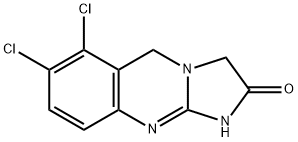Agrylin,Shire Pharmaceuticals
the treatment of primary thrombocytosis
Anagrelide; Potent PDE 3 inhibitorIt can be used to inhibit cancer cell invasion.
ChEBI: A 1,5-dihydroimidazo[2,1-]quinazoline having an oxo substituent at the 2-position and chloro substituents at the 6- and 7-positions.
6,7-Dicloro-1,2,3,5-tetrahydroimidazo[2,1-b]quinazolin-2-one was produced
from 6-chloro-7-bromo-1,2,3,5-tetrahydroimidazo[2,1-b]quinozolin-2-one by
substitution the bromine an equimolar quantity chlorine.
6-Chloro-7-bromo-1,2,3,5-tetrahydroimidazo[2,1-b]quinazolin-2-one was
produced next way: to a solution of 1.30 g (8 mmole) of anhydrous ferric
chloride in 30 ml of nitromethane was added 1.30 g (5 mmole) of solid 6-
chloro-1,2,3,5-tetrahydroimidazo[2,1-b]quinazolin-2-one and 0.80 g (5
mmole) of bromine. The system was stoppered, warmed to 50°C in an oil
bath overnight, cooled to room temperature and the solvent removed in
vacuo. The resulting solid was suspended in water (50 ml), the mixture was
made basic (pH=10) with sodium bicarbonate and stirred at home
temperature for 20 min. The solid was filtered under suction, washed with
water, then isopropyl alcohol and dried yielding 1.19 g of 6-chloro-7-bromo-
1,2,3,5-tetrahydroimidazo[2,1-b]quinazolin-2-one (78% yield). Purification
was effected by formation of the hydrochloride salt (mp 275°C) from
acetonitrile.
6-Chloro-1,2,3,5,-tetrahydroimidazo[2,1-b]quinazolin-2-one was produced
from 6-chloro-2-nitrobenzylchloride, ethylglycine hydrochloride and cyanogen
bromide in 3 steps.
Platelet aggregation inhibitor
This potent platelet aggregation inhibitor (FW = 256.09 g/mol; CAS 68475-42-3), also known as 6,7-dichloro-1,5-dihydroimidazo[2,1- b]quinazolin-2(3H)-one, BL-4162A, and Agrylin?, blocks the action of a variety of aggregating agents added platelet rich plasma, EC50 < 1 μg/mL, or 4 nM. Primary Mode of Action: Although the exact mechanism of its selective inhibition of megakaryocyte (MK) production of platelets remains uncertain, anagrelide is known to be a potent inhibitor of phosphodiesterase-II (IC50 = 36 nM) and lipoprotein-associated phospholipase A2 (or Lp-PLA2), the latter also known as platelet-activating factor acetylhydrolase (or PAF-AH). PDE-II hydrolyzes both cGMP and cAMP. Binding of cGMP to its regulatory GAF-B domain favors cAMP hydrolysis to 5’-AMP, thereby reducing cGMP hydrolysis to 5’-GMP. This property, which facilitates cross-regulation of the cAMP and cGMP pathways, suggests that a potent PDE-II inhibitor should potentiate the effects of cAMP and/or cGMP, the concentrations of which should increase in anagrelide-sensitive cells. Lp-PLA2 plays pivotal role in platelet maturation by specifically hydrolyzing Platelet-Activating Factor (PAF = acetyl-glyceryl-ether-phosphorylcholine) as well as other glycerophos-pholipids containing short, truncated, and/or oxidized fatty acyl groups at the sn-2 position of the glycerol backbone. At a final concentration of 100 ng/mL, anagrelide selectively blocks in vitro MK maturation, resulting in a 50% decrease in the total number of CD41a+ MKs. In humans, anagreline has the intriguing ability to promote as a species-specific platelet-lowering activity at dose levels lower than those required to inhibit platelet aggregation. Target(s): collagen- and immune complexinduced platelet aggregation and release; suppresses megakaryocytopoiesis by reducing the expression levels of the transcription GATA-1 and FOG-1 via a PDEIII-independent mechanism that is differentiation context-specific but does not involve inhibition of MPL-mediated early signal transduction events.
Potentially hazardous interactions with other drugs
Aspirin: potential risks and benefits must first be
assessed, additive antiplatelet effect.
Cilostazol: avoid concomitant use.
Grapefruit juice: may reduce clearance of anagrelide.
Phosphodiesterase inhibitors: avoid with milrinone
and enoximone.
Anagrelide is primarily metabolised by CYP1A2; less
than 1% is recovered in the urine as anagrelide. Two
major urinary metabolites, 2-amino-5, 6-dichloro-3,
4-dihydroquinazoline and 3-hydroxy anagrelide
(pharmacologically active) have been identified.
The mean recovery of 2-amino-5, 6-dichloro-3,
4-dihydroquinazoline in urine is approximately 18-35%
of the administered dose.



